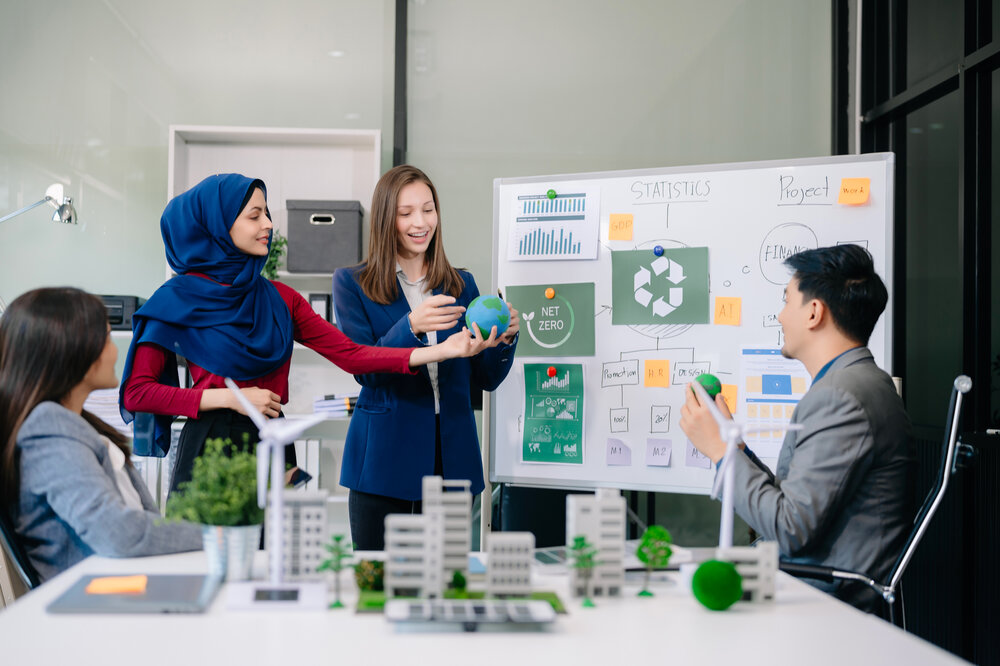Life Cycle Assessments (LCAs) provide a detailed life cycle analysis of a product or service’s environmental effects from raw material extraction through to disposal.
Following the internationally recognised phases of an LCA, including the scope of the study and Life Cycle Impact Assessment (LCIA), these assessments quantify greenhouse gas emissions and resource use across key impact categories like global warming potential.
Although often time-consuming, LCAs offer invaluable insights by revealing environmental hotspots within the cradle to gate and beyond, enabling companies to reduce their footprint and make informed sustainability decisions.
Our blog delves into the value of an LCA and gives an overview of the 5 main stages in undertaking a product life cycle assessment to better understand environmental impacts.
What is a Life Cycle Assessment?
An LCA measures something’s environmental impact from start to finish.
It’s a methodology usually delivered as a digital report backed by various software that calculates impacts across each life stage.
LCAs can assess the product life cycle involving anything from mining raw materials to end-of-life disposal (often called a cradle to grave approach) and beyond this they measure services, organisations, systems and processes.
For example, an LCA of an electric car tracks its environmental impact from raw material extraction to manufacturing, use and disposal using data and software to assess where the most harm occurs.
They’re used by sustainability professionals, policymakers, and any companies interested in understanding their environmental footprint.
Beyond carbon, it can track water use, air pollution, ozone depletion, land use change, toxicity, resource depletion and more.
This multi-dimensional view uncovers great detail for instance lithium in a car battery could have once been extracted in Uruguay using groundwater-intensive methods, and now lives inside an electric SUV driving through central London.
Companies typically commission LCAs from specialist consultants or LCA firms on a per-product/process basis, meaning that the flagship products could be assessed first.
ISO Standard Framework
The International Organization for Standardization (ISO) is a global, non-governmental organisation. ISO’s 14000 series is a family of broader environmental standards, with 14040 and 14044 recognising LCAs globally.
They define how LCAs should be carried out to meet global standards, with ISO 14040 setting out the principles and framework, then ISO 14044 going into detailed guidelines around data, assumptions, and documentation.
An LCA will not be ISO-compliant if it does not include a goal and scope, a defined functional unit, and an extensive LCI (Life Cycle Inventory). Each of these takes time and precision to ensure the LCA is robust and reduces the risk of greenwashing.
ISO standards are voluntary, not laws but without them, an LCA can be dismissed in tenders, ignored in academia, or rejected in sustainability claims. LCAs could fail to meet some formal expectations, including being eligible for peer review.
The Value of an LCA
LCAs add value because without them, the product’s genuine environmental impact is unknown.
They cover all bases to ensure impacts like water use, land degradation or toxicity aren’t missed which other reports such as a carbon footprint or sustainability summaries, might not consider.
LCAs add value to business, policymakers and consumers, as they allow you to transparently declare that a product or service is backed by robust environmental data.
This is invaluable for marketing, for meeting regulatory standards, and for building trust in environmental performance claims.
LCAs ensure compliance with regulations such as the UK Government’s Construction Playbook in the UK or the EU Ecodesign Directive in the EU. These can be verified by third-party auditors to confirm that environmental claims are accurate and credible.
Beyond business, LCAs are invaluable for climate change the assessments’ revelations can slash carbon emissions and counteract global warming, identify clean energy swaps, expose high-impact supply chain links, and much more such as highlighting design changes that reduce waste or pollution.
The typical framework for product-focused LCAs is the 5 following stages.

1. Raw Material Extraction
Raw material extraction is the crucial first step in a product’s life cycle, where natural resources are taken from the environment to create the materials needed.
An extraction impact refers to which environmental and social effects that occurred when the resources were taken from the planet considering everything from local water use to distant habitat loss.
This is the starting point for LCAs as it sets the baseline for the initial level of environmental impact that everything else will build upon. A smartphone could have a starting point of 20 kg CO₂e, then rising to 80 kg CO₂e around its use phase, following processes of energy use, emissions, resource depletion.
Different materials have vastly different footprints, with those like aluminium and lithium being much more carbon-intensive than others like plastic or glass.
The first stage of the LCA process, the assessor collects data around which natural resources went into making the product, the energy consumed in the process, emissions released, and waste generated.
At the end of stage 1, data collection on raw material extraction should be quantified in the Life Cycle Inventory (LCI) spreadsheet or database. This is entered into an LCA software like OpenLCA or GaBi, which calculates the impact by modelling environmental burdens across multiple categories, identifying sustainable alternatives and hotspots for improvement.
Adopting sustainable sourcing and recycling can significantly reduce the environmental damage caused by raw material extraction.
2. Manufacturing & Processing
Manufacturing and processing transform raw materials into finished products, often using significant energy and resources.
These operations take place in industrial facilities like factories and manufacturing plants, which tend to be energy-intensive due to processes like metal smelting and chemical treatments. As a result, this stage typically accounts for a significant portion of the total energy identified in the LCA.
This uses primary data such as material quantities purchased or factory electricity, however gaps are frequently left between. Secondary data is then collated from literature, industry reports or other sources to fill any gaps.
A key method of analysis here is inputs and outputs measuring exactly how many resources are consumed, and subsequently how much waste goes out. Moreover, inventory analysis gathers detailed data about the emissions, waste, materials, and energy that went into creating the product.
LCA assessments here can shape product designs, with smarter choices such as biodegradable plastics instead of conventional plastics saving tons of carbon emissions and slashing environmental impacts.
This could also call for better waste reduction strategies like process optimisation, strategy re-thinks, omitting harmful chemicals, recycling increases, cleaner tech, and improved packaging designs.
3. Distribution & Transportation
After extracting the materials and making the product, it must then be shipped out to its consumers, or for further processing requirements such as assembly or finishing.
It’s packed in trains, ships, trucks, planes with vastly different emission averages. Different types of packaging also weigh in on emission levels, with paper/paperboard generally on the safer end, but plastic caps as high as 8.08 kg CO₂e per kg.
In an LCA assessment, fuel use, distances, and transport modes are quantified in line with accessible supply chain logistics data.
This considers upstream and downstream across a range of data sources, from shipping records to consumption reports.
This method also uses input, output, and inventory analysis for a comprehensive view.
Transport can account for a significant amount of the carbon footprint. As a result, routes often get optimised, packaging is made lightweight, and cleaner fleets are optimised.
4. Use Phase
After material extraction, manufacturing, and shipping, it’s finally time the product gets used. A product begins its active life the second the consumer starts using it.
It then uses resources; a washing machine uses water, a refrigerator uses energy, and most electronic devices use electricity every time they are turned on.
This is near impossible to measure in real time across a globe of consumers, so LCA models use scenarios and averages. User data is collected from surveys and smart device data, and this feeds the scenarios as average usage patterns.
Moreover, data inputs are taken from the electricity mix (regional and national average data from electricity sources) as data is incredibly hard to obtain for individual usage.
After completing this stage, you’ll have a multi-dimensional view of how the product is being used, what it’s using, for how long, and its associated environmental impact during use.
These insights encourage re-thinks of energy-intensive products; potentially swapping components to more efficient alternatives or switching levels of power consumption.
5. End of Life (Disposal or Recycling)
When a product breaks, goes out of trend, expires, or is no longer used, its active life ends. In circular economies, products are fixed and refurbished for a second life, but in our current linear economies, they become waste and are disposed of.
LCAs are essential to recognising these realities and uncovering ways to minimise environmental impact during disposal or recycling.
They track material flows to recycling or disposal facilities, plus quantify emissions from landfill, incineration, or recycling processes. Waste management is a problematic industry LCAs reveal when products are discarded prematurely and when recycling systems fall short.
They expose inefficiencies and highlight the importance of designing with circularity in mind from the earliest stages. This could be switching materials like mixed plastics to recyclable options like PET or HDPE, or hard-to-break-down resources like certain synthetic fabrics into biodegradable options like organic cotton or bamboo.
Overall, life cycle assessments began back in the 60s and are just now becoming standard practice for many industries. Not yet universal; broader regulatory adoption could ensure more and more processes leave as little an impact on the planet as they can.
More Information
https://www.nationalgrid.com/stories/energy-explained/what-are-scope-1-2-3-carbon-emissions
https://www.ricardo.com/en/services/advisory/climate-transition-plans
https://www.sciencedirect.com/topics/earth-and-planetary-sciences/life-cycle-assessment
https://sphera.com/solutions/product-stewardship/life-cycle-assessment-software-and-data
https://www.rit.edu/sustainabilityinstitute/blog/what-life-cycle-assessment-lca
https://ghgprotocol.org/sites/default/files/2022-12/Chapter4.pdf

